Abstract
Agonist binding to the muscarinic receptor in rat cerebral cortex membranes was studied by using the neurotransmitter itself, [3H]acetylcholine [( 3H]AcCho). By using 10 microM atropine or oxotremorine to define specific binding, it was possible to demonstrate specific binding of [3H]AcCho that was sensitive to muscarinic but not to nicotinic ligands. Equilibrium binding experiments with 5-240 nM [3H]AcCho indicated specific binding of the ligand to a saturable population of muscarinic receptors (361 +/- 29 fmol/mg of protein; Kd = 76 +/- 17 nM). This value represented 25% of the available binding sites for a labeled antagonist in the same preparation and corresponds to the proportion of high-affinity agonist binding sites observed previously in competition experiments with labeled antagonists. Inclusion of transition metal ions (e.g., 2 mM Ni2+) in the assay increased the equilibrium binding of [3H]AcCho (628 +/- 38 fmol/mg of protein, Kd = 86 +/- 21 nM) but did not affect equilibrium binding of 3H-labeled antagonists, indicating conversion of low- into high-affinity muscarinic agonist binding sites. The increase developed slowly over 30 min of incubation at 25 degrees C but could be reversed rapidly (approximately equal to 2 min) by the chelating agent EDTA or by guanine nucleotides. These data directly reveal a slow though quickly reversible interconversion of low- into high-affinity muscarinic agonist binding sites.
Full text
PDF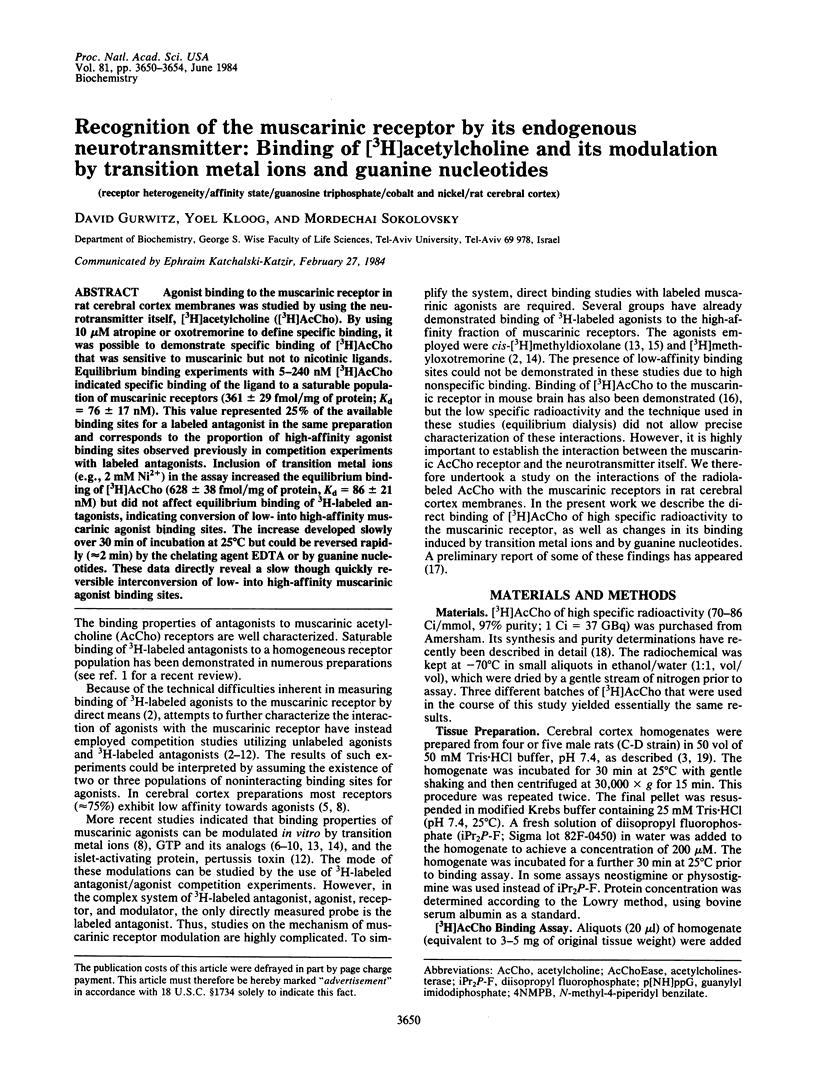
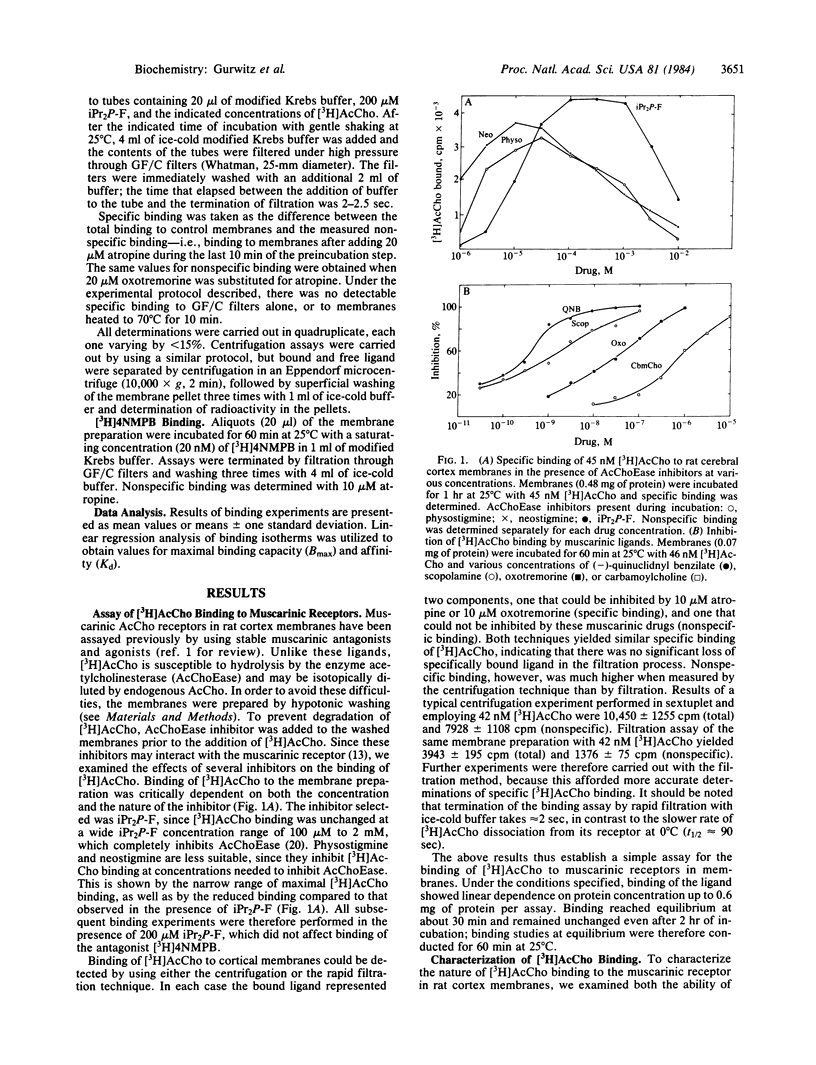
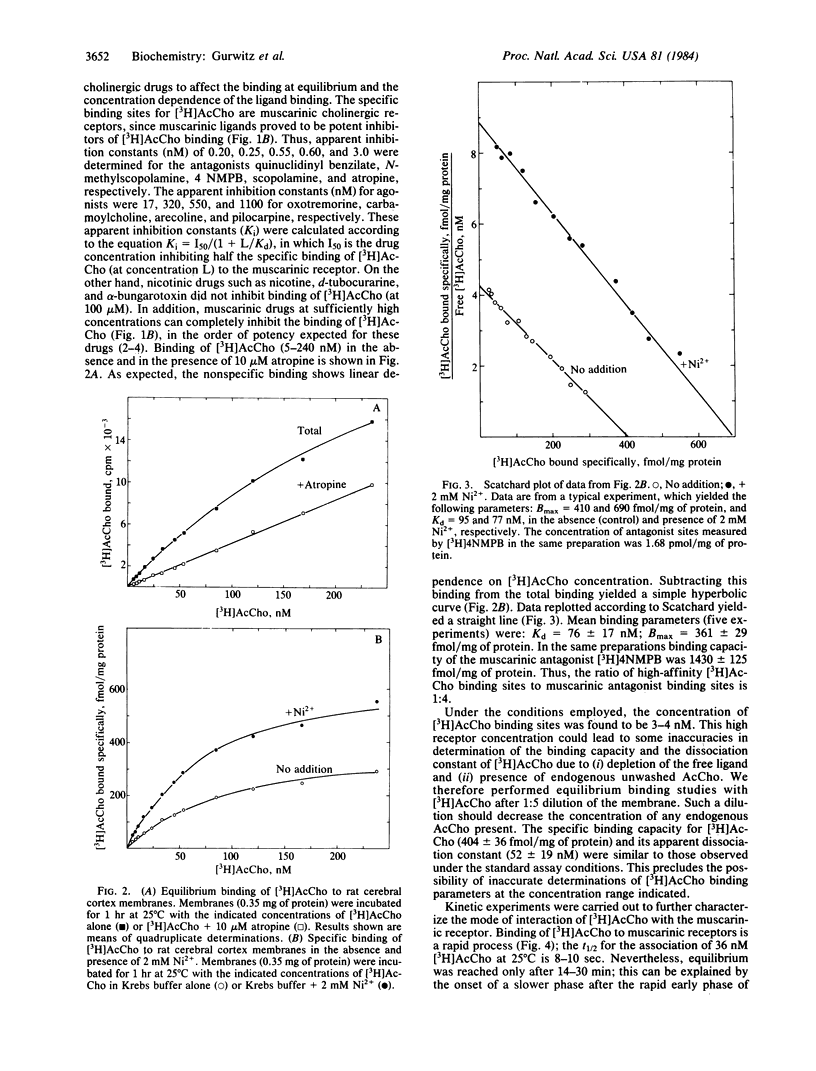
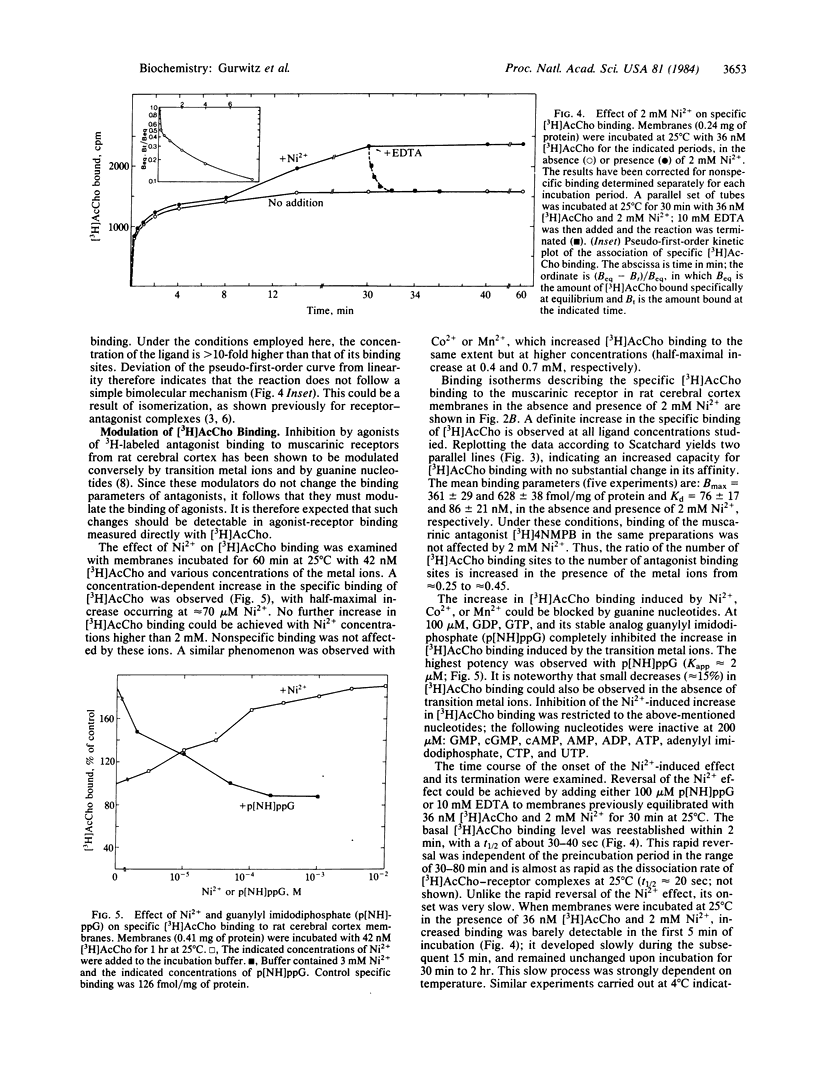
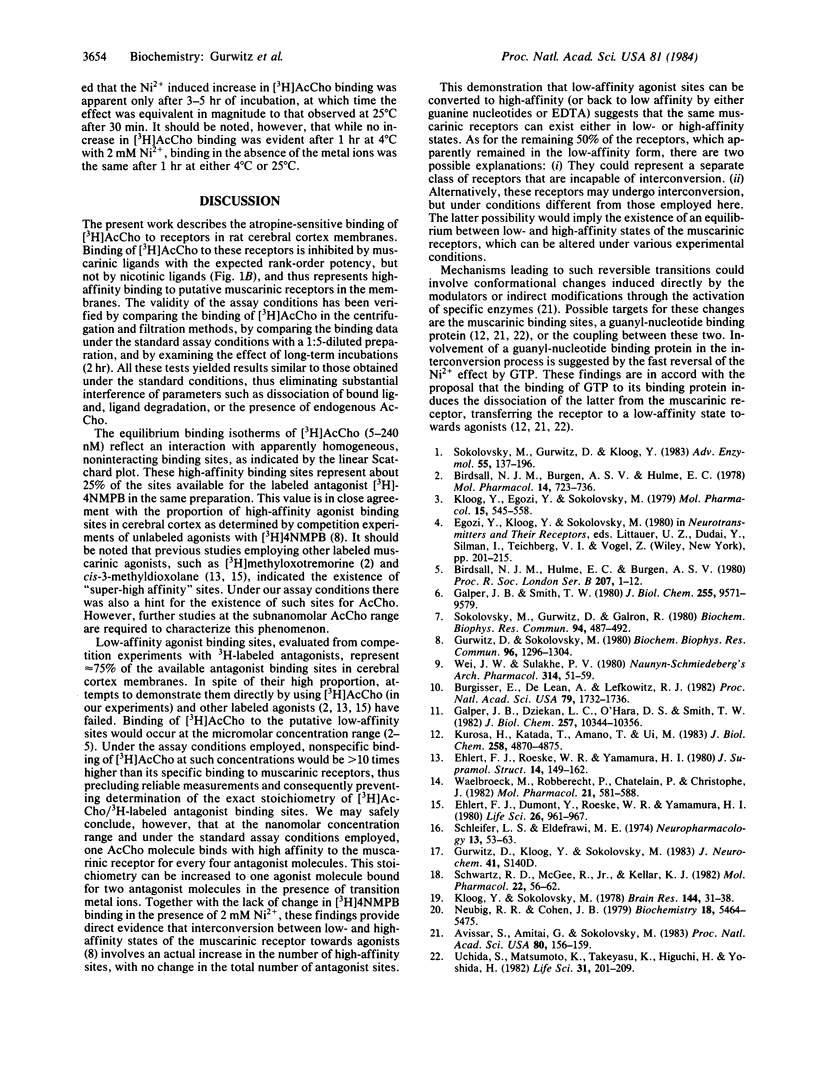
Selected References
These references are in PubMed. This may not be the complete list of references from this article.
- Avissar S., Amitai G., Sokolovsky M. Oligomeric structure of muscarinic receptors is shown by photoaffinity labeling: subunit assembly may explain high- and low-affinity agonist states. Proc Natl Acad Sci U S A. 1983 Jan;80(1):156–159. doi: 10.1073/pnas.80.1.156. [DOI] [PMC free article] [PubMed] [Google Scholar]
- Birdsall N. J., Burgen A. S., Hulme E. C. The binding of agonists to brain muscarinic receptors. Mol Pharmacol. 1978 Sep;14(5):723–736. [PubMed] [Google Scholar]
- Birdsall N. J., Hulme E. C., Burgen A. The character of the muscarinic receptors in different regions of the rat brain. Proc R Soc Lond B Biol Sci. 1980 Feb 13;207(1166):1–12. doi: 10.1098/rspb.1980.0011. [DOI] [PubMed] [Google Scholar]
- Burgisser E., De Lean A., Lefkowitz R. J. Reciprocal modulation of agonist and antagonist binding to muscarinic cholinergic receptor by guanine nucleotide. Proc Natl Acad Sci U S A. 1982 Mar;79(6):1732–1736. doi: 10.1073/pnas.79.6.1732. [DOI] [PMC free article] [PubMed] [Google Scholar]
- Ehlert F. J., Dumont Y., Roeske W. R., Yamamura H. I. Muscarinic receptor binding in rat brain using the agonist, [3H]cis methyldioxolane. Life Sci. 1980 Mar 24;26(12):961–967. doi: 10.1016/0024-3205(80)90117-4. [DOI] [PubMed] [Google Scholar]
- Ehlert F. J., Roeske W. R., Yamamura H. I. Regulation of muscarinic receptor binding by guanine nucleotides and N-ethylmaleimide. J Supramol Struct. 1980;14(2):149–162. doi: 10.1002/jss.400140204. [DOI] [PubMed] [Google Scholar]
- Galper J. B., Dziekan L. C., O'Hara D. S., Smith T. W. The biphasic response of muscarinic cholinergic receptors in cultured heart cells to agonists. Effects on receptor number and affinity in intact cells and homogenates. J Biol Chem. 1982 Sep 10;257(17):10344–10356. [PubMed] [Google Scholar]
- Galper J. B., Smith T. W. Agonist and guanine nucleotide modulation of muscarinic cholinergic receptors in cultured heart cells. J Biol Chem. 1980 Oct 25;255(20):9571–9579. [PubMed] [Google Scholar]
- Gurwitz D., Sokolovsky M. Agonist-specific reverse regulation of muscarinic receptors by transition metal ions and guanine nucleotides. Biochem Biophys Res Commun. 1980 Oct 16;96(3):1296–1304. doi: 10.1016/0006-291x(80)90092-3. [DOI] [PubMed] [Google Scholar]
- Kloog Y., Egozi Y., Sokolovsky M. Characterization of muscarinic acetylcholine receptors from mouse brain: evidence for regional heterogeneity and isomerization. Mol Pharmacol. 1979 May;15(3):545–558. [PubMed] [Google Scholar]
- Kloog Y., Sokolovsky M. Studies on muscarinic acetylcholine receptors from mouse brain: characterization of the interaction with antagonists. Brain Res. 1978 Apr 7;144(1):31–48. doi: 10.1016/0006-8993(78)90433-x. [DOI] [PubMed] [Google Scholar]
- Kurose H., Katada T., Amano T., Ui M. Specific uncoupling by islet-activating protein, pertussis toxin, of negative signal transduction via alpha-adrenergic, cholinergic, and opiate receptors in neuroblastoma x glioma hybrid cells. J Biol Chem. 1983 Apr 25;258(8):4870–4875. [PubMed] [Google Scholar]
- Neubig R. R., Cohen J. B. Equilibrium binding of [3H]tubocurarine and [3H]acetylcholine by Torpedo postsynaptic membranes: stoichiometry and ligand interactions. Biochemistry. 1979 Nov 27;18(24):5464–5475. doi: 10.1021/bi00591a032. [DOI] [PubMed] [Google Scholar]
- Schleifer L. A., Eldefrawi M. E. Identification of the nicotinic and muscarinic acetylcholine receptors in subcellular fractions of mouse brain. Neuropharmacology. 1974 Jan;13(1):53–63. doi: 10.1016/0028-3908(74)90007-0. [DOI] [PubMed] [Google Scholar]
- Schwartz R. D., McGee R., Jr, Kellar K. J. Nicotinic cholinergic receptors labeled by [3H]acetylcholine in rat brain. Mol Pharmacol. 1982 Jul;22(1):56–62. [PubMed] [Google Scholar]
- Sokolovsky M., Gurwitz D., Galron R. Muscarinic receptor binding in mouse brain: regulation by guanine nucleotides. Biochem Biophys Res Commun. 1980 May 30;94(2):487–492. doi: 10.1016/0006-291x(80)91257-7. [DOI] [PubMed] [Google Scholar]
- Sokolovsky M., Gurwitz D., Kloog J. Biochemical characterization of the muscarinic receptors. Adv Enzymol Relat Areas Mol Biol. 1983;55:137–196. doi: 10.1002/9780470123010.ch2. [DOI] [PubMed] [Google Scholar]
- Uchida S., Matsumoto K., Takeyasu K., Higuchi H., Yoshida H. Molecular mechanism of the effects of guanine nucleotide and sulfhydryl reagent on muscarinic receptors in smooth muscles studied by radiation inactivation. Life Sci. 1982 Jul 19;31(3):201–209. doi: 10.1016/0024-3205(82)90579-3. [DOI] [PubMed] [Google Scholar]
- Waelbroeck M., Robberecht P., Chatelain P., Christophe J. Rat cardiac muscarinic receptors. I. Effects of guanine nucleotides on high- and low-affinity binding sites. Mol Pharmacol. 1982 May;21(3):581–588. [PubMed] [Google Scholar]
- Wei J. W., Sulakhe P. V. Requirement for sulfhydryl groups in the differential effects of magnesium ion and GTP on agonist binding of muscarinic cholinergic receptor sites in rat atrial membrane fraction. Naunyn Schmiedebergs Arch Pharmacol. 1980 Oct;314(1):51–59. doi: 10.1007/BF00498431. [DOI] [PubMed] [Google Scholar]


